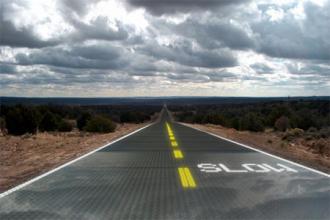Blog Post: The Future of Solar Roads

What is the solution to Global Warming? That is the question that Julie and Scott Brusaw asked themselves. Their answer was Solar Roadways. In 2009 they succeeded in making their vision a reality when they received a contract from the United States Federal Highway Administration to build a prototype.
The basic idea behind the Solar Road Panel is to combine extremely durable material with solar cells to collect solar energy. The top layer is made from strong, self cleaning glass which is textured to enhance traction. An electronic layer of LED lights is added under the glass to "paint" the lines on the road, and a heating element to melt frost and snow. There is also a microprocessor embedded within each panel to monitor and control the lights, heaters and communication between panels. The base layer distributes power to street lights and buildings. The Brusaw's vision is to completely replace all petroleum-based asphalt roads and parking lots with Solar Road Panels, which they calculate will be able to supply enough green electricity to cut greenhouse gases in half.
There are several other benefits of Solar Roadways. Solar roads would make electricity for electric vehicles much more accessible and engineers are working on ways to power electric vehicles directly from Solar Roadways while driving. In addition, including LED lighting on roadways has been shown to reduce night time accidents by 70%. Smart technology in the panels will allow opening and closing of lanes, provide traffic, pedestrian and wildlife warnings, and include speed indicators to reduce accidents and traffic congestion. Solar Roadways have multiple applications and while expensive to build will pay for themselves over the course of their lifespans.
Researchers at the University of Rhode Island and Worcester Polytechnic Institute are also working on their own ideas for solar roads technology. Rhode Island researchers are working on putting solar cells in Jersey Barriers (modular concrete barriers) which divide roads and highways. These cells could help power street lights and road signs. Researchers are also experimenting with putting water pipes under the road surface to collect heat energy which could be used to run steam turbines for energy or simply store heat to melt ice on the road. At Worcester, researchers are putting heat exchangers into asphalt roads to collect solar heat which can be used to create electricity and heat water.
For more information:
http://solarroadways.com/intro.shtml
http://www.uri.edu/news/releases/?id=5584
http://www.wpi.edu/news/20101/asphaltnews.html
__________
Category:


































